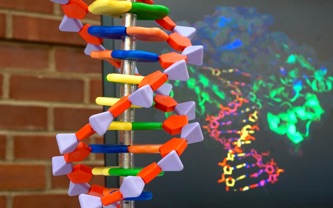ZHAO Research Laboratory
Department of Chemistry
& Environmental Toxicology Graduate Program
University of California, Riverside

ZHAO Research Laboratory
Department of Chemistry
& Environmental Toxicology Graduate Program
University of California, Riverside
Copyright 2013-2022 Zhao Lab | Contact: linlin.zhao@ucr.edu
DNA damage is safeguarded by an intricate DNA repair network and several DNA damage tolerance mechanisms; nonetheless, certain DNA lesions can escape repair or exceed the repair capacity and eventually accumulate in the genome. The persisted DNA lesions can interfere with DNA transactions, leading to cell cycle arrest, mutations, and cell death. An altered genetic content in key regions, such as proto-oncogenes and tumor suppressor genes, is a major driving force for human diseases including cancer. Translesion synthesis (TLS) is a conversed DNA damage tolerance mechanism, whereby specialized DNA polymerases participate in copying past obstructive DNA structures, such as DNA lesions or non-canonical DNA structures. Because TLS is error-prone, it plays an important role in mutagenesis.




We are grateful to our sponsors



The project seeks to obtain mechanistic insights into the DNA-binding proteins and enzymes, including TLS polymerases and nucleases. We use enzyme kinetics, kinetic simulations, and X-ray crystallography, and mass spectrometry-based methods to dissect the basis of faulty DNA replication past DNA lesions or how DNA enzymes operate on lesion-containing DNA substrates.
Zhao et al. DNA Repair, 2024, 137, 103666.
Zhao et al. ACS Chem. Biol. 2023, 18, 5, 1168–1179.
Urrutia et al. J Biol. Chem. 2022, 289, 102306.
Xu et al. Biochemistry, 2015, 54, 639-651.
Xu et al, J Mol. Biol. 2019, 431, 673-686.
Mitochondria are critical for energy production, cell signaling, and the biosynthesis of protein cofactors in higher eukaryotic cells. The mitochondrial DNA (mtDNA) genome is indispensable for mitochondrial function because it encodes protein subunits of the electron transport chain and a full set of transfer and ribosomal RNAs. mtDNA degradation is an essential mechanism in mitochondrial genomic maintenance and damage response.
enzymology of DNA replication and repair
Mitochondrial DNA degradation

The project aims to decipher the chemical and molecular basis of mitochondrial DNA turnover. Mitochondrial transcription factor A (TFAM) is abundant DNA packaging protein and an important protein for transcription and mitochondrial DNA maintenance. We recently discovered a novel role of TFAM in facilitating the degradation of damaged DNA containing abasic sites. We found that TFAM could accelerate the strand breakage rate at abasic sites by 2 to 3-orders of magnitude relative to naked DNA. TFAM competes effectively with AP endonuclease, considering the abundance of TFAM in mitochondrial nucleoids. Recently, we have demonstrated such a role of TFAM in cells by detecting TFAM-DNA cross-links. Our working model is that TFAM facilitates mtDNA turnover through collaborations with nucleases and other factors. In addition, we are interested in the role of mitochondrial nucleases, such as mitochondrial genome maintenance exonuclease 1 (MGME1), in mtDNA turnover.
Urrutia et al. Nucleic Acids Res, 2024, 52 (22), 14093-14111.
Xu et al. Nucleic Acids Res, 2023, 1, 41-53
Zhao et al. ACS Chem Biol, 2023
Xu et al. PNAS. 2019, 116, 17792-17799


developing DNA sequencing technologies for DNA modifications
DNA is susceptible to chemical and physical agents from endogenous and environmental sources, producing various DNA modifications. Research has documented a plethora of DNA modifications, including more than 50 endogenous nucleobase modifications and many covalent adducts derived from environmental chemicals. Certain DNA modifications function in gene regulation, whereas other lesions have mutagenic and pathogenic effects. Recent sequencing data have revealed that the distribution of DNA modifications in the genome is not uniform. Mapping DNA modifications on a genome-wide scale is critical for clarifying their roles in genetic regulation, development, and pathogenesis. Unfortunately, current methods for sequencing DNA modifications suffer from one or more drawbacks in terms of sensitivity, specificity, resolution, and throughput. This project addresses these limitations by developing a novel DNA sequencing method on Illumina sequencers to map multiple DNA modifications simultaneously. The research exploits the chemistry of DNA repair and develops highly specific chemical probes for sequencing multiple DNA modifications at single-nucleotide resolution. These novel chemicals capture and enrich abasic (AP) sites, a central intermediate in DNA repair. In addition, two chemical probes serve as unique locator codes during amplification, allowing sequencing readout. Simultaneous mapping of different DNA lesions will be achieved through coupling lesion-specific DNA repair enzymes with multiplex sequencing. In the long run, the developed technology will aid the generation of single-nucleotide resolution genomic maps for various DNA modifications in a high- throughput and cost-effective manner. The resulting DNA modification maps will be used to correlate with mutation signatures of chemical exposures or under pathological conditions.
Liu et al. Nucleic Acids Res, 2023, 51, e73 https://doi.org/10.1093/nar/gkad502
Tang et al. Anal Chem. 2021, 93, 13398-13406 Zhao and Sumberaz, Chem. Res. Toxicol. 2020, 33, 2491-2502
Zhao, The Enzymes. 2019, 45, 311-341;